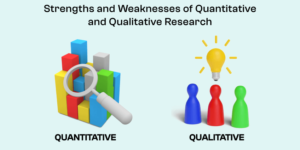
Effective research in every field is significant to witness success. In that instance, choosing the best quantitative and qualitative research tools is the first thing to ensure.
Want to know about the research tools and techniques in detail? Then, this article takes you on a tour of the best and unique strategies and software available in the latest trends. So, get ready to harness the power of tools and enhance your research.
But have you ever wondered why it plays a crucial role in business success?
Even if you haven’t yet, then this post will be a great help, for that matter!
So, keep reading!
Table of Contents
- Introduction
- Best Qualitative Analysis Tools
- Best Qualitative Data Analysis Methodologies
- Examples Of Qualitative Research
- Best Quantitative Research And Analysis Tools
- Best Quantitative Research And Analysis Methodologies
- Examples Of Quantitative Research
- Difference Between Quantitative And Qualitative Research
Introduction
Investing your time in examining the potential needs of consumers or targeted communities assists you in identifying their exact requirements. In addition, it triggers your innovation that adds more value to your products or services.
However, there are different types of research, including case studies, surveys, descriptive, exploratory, qualitative, focus groups, cross-sectional, and quantitative. Among them, quantitative and qualitative research tools and techniques come under high priority due to their accuracy.
Quantitative analysis tools are essential for examining research outcomes and enhancing the overall tracking and growth of a business. Both quantitative and qualitative research tools are often known by their strategies, methods, and types.
You need to dig deeper into these methods, types, examples, and information. So, if you’re looking for the best research tools, then scroll down to read the full article.
Here, we have outlined some of the best methods and tools for you to make an informed choice. Choose the one that fits your needs the best, and be sure to increase sales and attract potential customers.
Take a glance at them in detail; let’s get started.
Best Qualitative Analysis Tools
Here, you can get to know about the best qualitative analysis tools that fasten your research process and elevate business growth.
1. NVivo

Are you looking for tech-savvy quantitative and qualitative research tools? Then, you must choose the NVivo analyzing tool and identify the gaps based on customer-focused and qualitative research. It is an excellent choice for mid-sized companies as it consistently delivers accurate results for every survey.
NVivo can analyze different types of data, like text, audio, video, etc, and can effectively spot the recurring themes in customer feedback. However, it is pretty expensive and still worth it. You can choose to purchase this tool in order to elevate your business to the next level.
Price: NVivo offers a FREE TRIAL, and its paid version starts from $ 1249.
2. MAXQDA
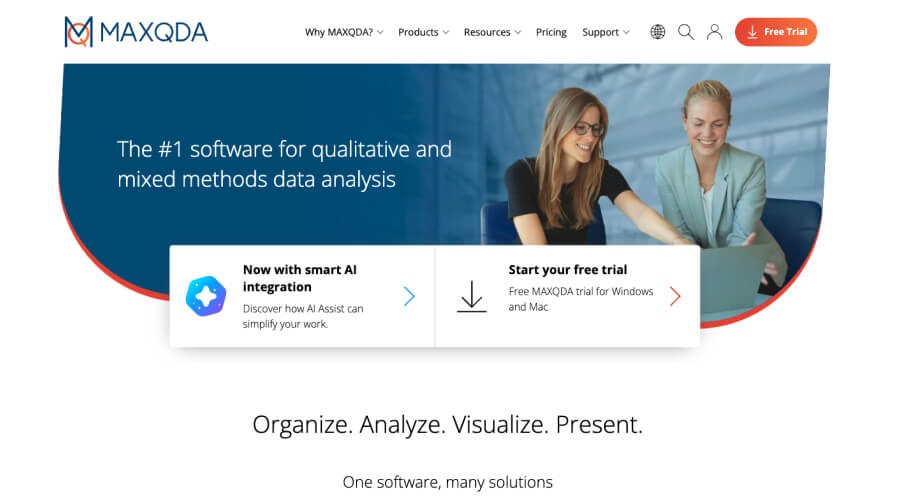
When it comes to the best data analysis software that can assist in organizing a wide range of data from feedback or surveys, MAXQDA tops the list. This is one of the best tools for both qualitative and quantitative analysis, as MAXQDA combines the qualitative and quantitative methods to obtain deeper insights. Many established organizations are already using MAXQDA to get accurate results. If you are also looking for the best quantitative and qualitative research tool, then this is the one for you.
Price: It has a free trial and a paid version. The paid version starts from $45.00
3. ATLAS.ti
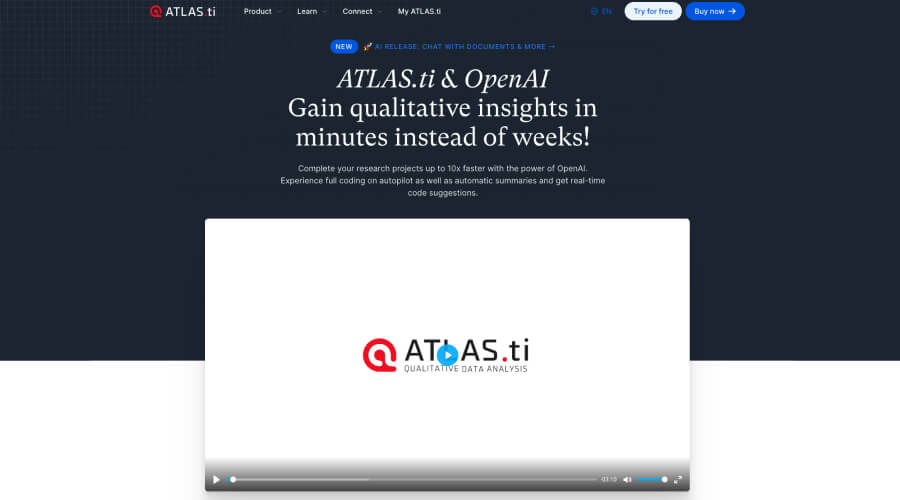
ATLAS.ti is a special software created to help business owners and entrepreneurs. Not only does it help attain better outcomes, but also it helps overcome challenges. You can analyze the constraints according to the time and various resources.
You can utilise various qualitative research methods to analyse questions an d surveys, as well as conduct prototype testing. Utilise charts and graphs to visually represent the overall results, aiding in efficient sorting and analysis.
ATLAS.ti is the most preferable qualitative research tool that assists you to get apt results before launching a new product or in the testing phase.
Price: ATLAS.ti offers a FREE version and trial. The monthly subscription starts from $ 10.00.
4. Quirkos
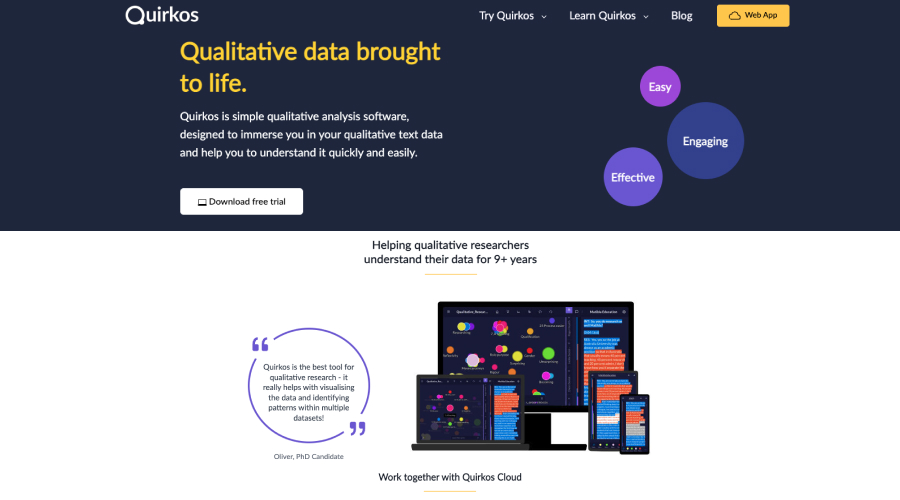
Quirkos is the most affordable qualitative analysis tool that can identify the common keywords in text to boost the business. The comparison model gives you a clear view of different sets of targeted audiences like age groups, geometrical tags, gender, etc.
Therefore, consider Quirkos, the best qualitative analysis tool that is easy to adapt and gives accurate results according to the business.
Price: It has a free trial, and a monthly subscription starts from $ 6.00
5. Thematic
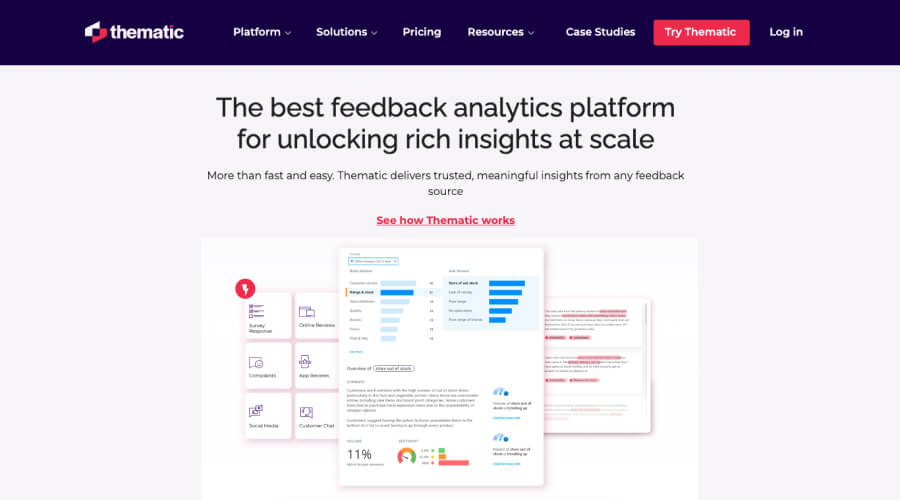
Next on our list is Thematic. It is one of the best qualitative analysis tools available in the market. It is an AI-driven text feedback analysis platform. It assists you in getting clarity on customer’s details and what they exactly need.
This qualitative analysis tool inspects unstructured reports across various channels, reveals emerging trends, and separates insights according to the customer segment. And then use the comprehensive data-driven results for predictive analysis. If you are looking for a tool that can help you make informed decisions, choose the Thematic tool.
Price: Annual subscription starts from 190.00 Euro
6. Dovetail
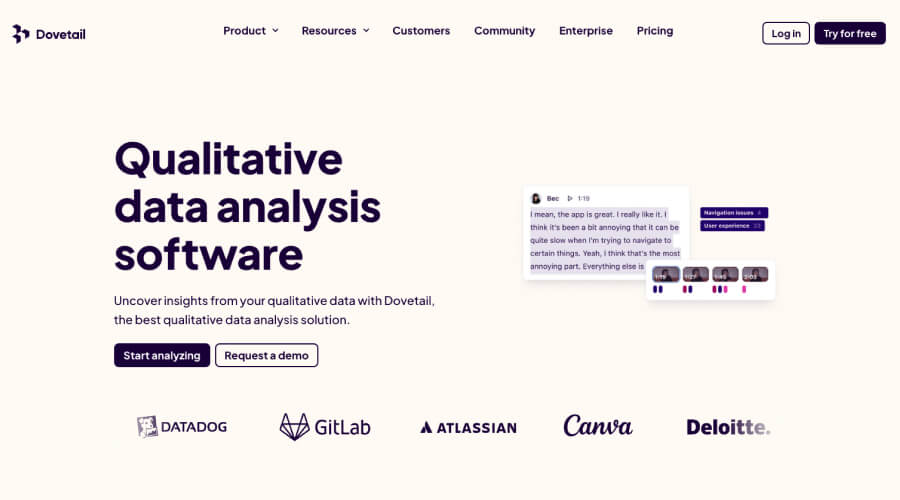
This customer research platform offers three tools Backstage, Markup, and Playback. Opt for Markup in the Dovetail platform for effective qualitative analysis. Dovetail is a pretty effective tool for qualitative analysis. It transcribes recordings automatically and conducts sentiment analysis to get apt results.
The Dovetail platform is the best way to test or analyze everything from planning to reporting. Thus, choose Dovetail and enhance your qualitative analysis.
Price: It offers both a FREE trial and a paid version. The monthly price starts from $ 30.00.
7. Qualtrics
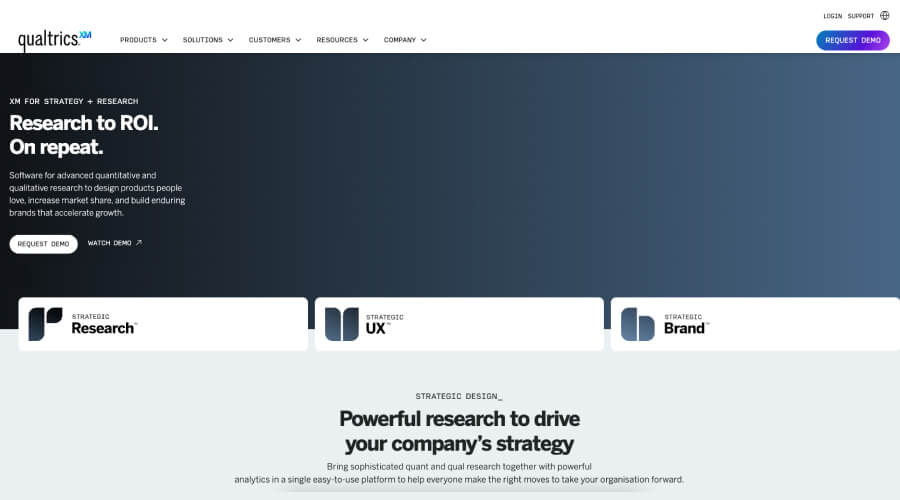
It is a popular platform that offers enormous tools for sophisticated management. When conducting qualitative analysis, it is important to prioritize the use of Qualtrics CoreXM. This tool is specifically designed to assist in evaluating product ideas, identifying market gaps, and other related tasks.
To achieve comprehensive search and analytical outcomes, Qualtrics is a valuable tool that allows you to tailor your products or services to meet your specific needs.
Price: To know about Qualtrics XM pricing details, visit the official site as it varies based on your requirement.
8. Delve
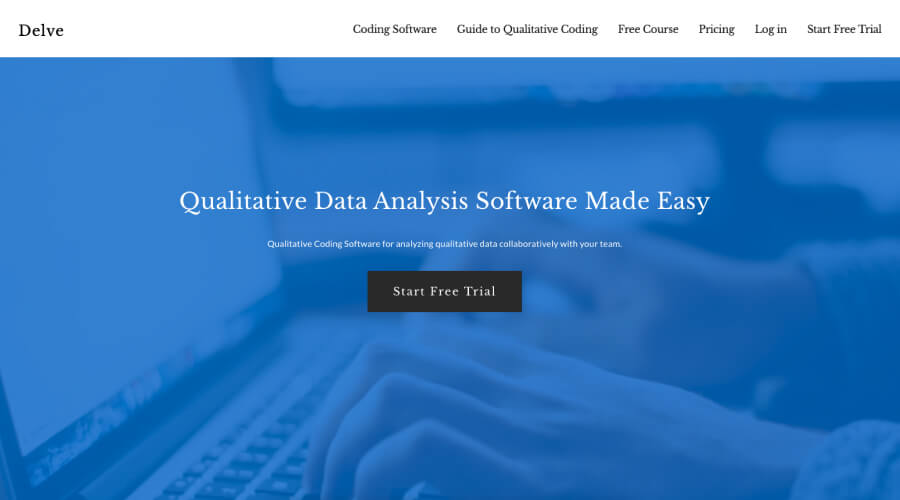
Delve is a highly suitable tool for efficiently coding large volumes of textual data. It is widely regarded as the top choice for conducting qualitative analysis on extensive customer feedback. It has the ability to identify groups and customer feedback and categorize the data based on specific criteria. Additionally, it is capable of conducting various operations such as thematic analysis, narrative analysis, and grounded theory analysis.
Therefore, you have the option to choose this highly effective qualitative analysis tool in order to enhance the growth of organizations and surveys.
Price: It comes with a FREE trial, and pricing starts from $50.00.
9. MonkeyLearn
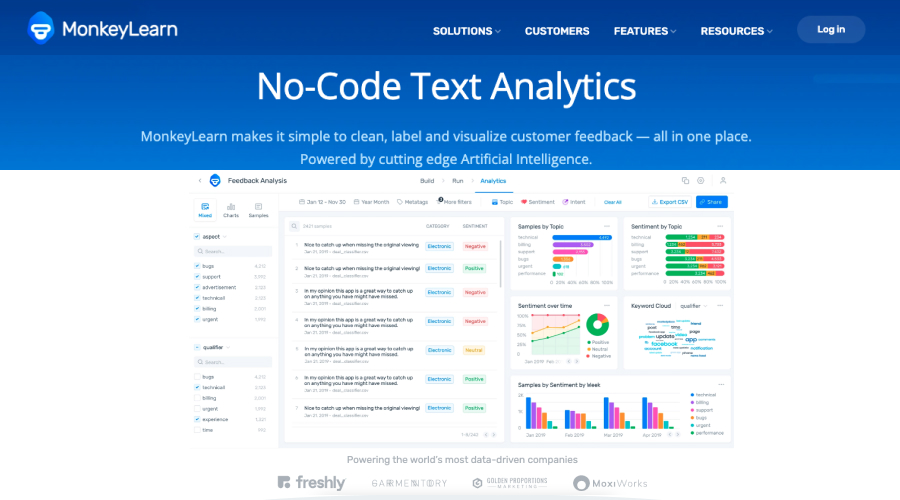
Next on our list is MonkeyLearn. This qualitative analysis tool automatically prioritizes, sorts, and visualizes customer feedback. This AI-powered tool is excellent for qualitative analysis. With the AI-powered algorithm, it organizes data into themes and split positive reviews, requests, and addresses immediately.
Plus, it can analyze the high-end text and keywords and easily sort to initiate processing the value. Try to utilize the power of MonekyLearn, the AI-powered tool, to elevate your research and analysis results.
Price: It varies according to your requirements, so check the official website
10. Cauliflower

It is one of the top-rated qualitative analysis tools for examining customer survey data and understanding the reviews. The key aspect to focus on during qualitative analysis is the survey reports of the potential targeted community. Cauliflower is able to visually represent the information of the targeted community without the need to read the content.
This customer feedback analysis tool uses Artificial Intelligence to provide insights into customer feedback. Other than this, it has features like processing and understanding customer reviews, examining social media channels, and prioritizing product testing. Therefore, to witness effective results, you must choose Cauliflower, the best qualitative analysis tool.
Price: It has a free trial, and a monthly subscription starts from 499.9 Euro. You can start with a FREE TRIAL to get a grip on this tool.
Therefore, opt for these unique and highly rated qualitative analysis tools and establish or complete your project goals promptly. Here are some examples of qualitative research for you; take a look…
Best Qualitative Data Analysis Methodologies
1. Content Analysis
Content is in the mainstream these days. The content analysis method is used to systematically analyze and interpret the content of various forms, including written, recorded, and so on. This research method involves examining and quantifying the occurrence of specific words, subjects, and concepts in different forms of communication, such as text, images, videos, or audio messages. The method converts qualitative input into quantitative data, enabling marketers to draw reliable conclusions about their brand’s perception among customers and identify ways to enhance their experience and opinion.
Marketers and customer service specialists frequently utilize content analysis to gain insights into customer behaviour and evaluate brand reputation. It can either be conducted manually or with the help of tools. Using tools is the easiest way to get things done in the most efficient manner. These methods help to identify patterns in communication, detect variations in communication trends among individuals or groups, and establish connections between different concepts.
Example of Content Analysis: Customer survey using open-ended questions.
2. Narrative Analysis
Another very popular qualitative analysis method includes Narrative analysis. Narrative analysis is used to examine and interpret stories or narratives. It involves interpreting the stories of research participants. These stories can take various forms, such as testimonials, case studies, interviews, or other types of text or visual data.
You can get valuable insights and understanding by examining the stories and narratives that individuals share. By analysing these narratives, your team can gain a deeper understanding of the experiences, perspectives, and emotions that can help foster better communication and collaboration.
This method usually includes reviewing customer stories, such as those shared on social media platforms. This approach allows researchers to gain deeper insights into customers’ lives, priorities, and challenges.
3. Thematic Analysis
Thematic analysis method is used to identify and analyse patterns, themes, and meanings within qualitative data. It involves systematically organizing and examining patterns of meaning within a specific data set, such as a collection of interviews or transcripts from focus groups. This method involves organizing data, which are often large, into groups based on similarities, known as themes. Thematic analysis plays a crucial role in helping researchers understand the content and extract significance from it.
It is one of the valuable tools for gaining insights into people’s experiences, perspectives, and opinions.
4. Grounded Theory
Grounded theory is a research methodology that aims to develop theories based on data collected from the field. It is a highly effective qualitative analysis method that aims to develop new theories based on the available data.
This approach involves a systematic process of conducting tests. Also, it involves making revisions to refine and validate the emerging theories. This method is particularly popular as a research design type rather than an analysis method.
Instead of forcing preexisting hypotheses or theories upon the study, the key to grounded theory is to go into it with an open mind and let the data guide the interpretation.
5. Discourse Analysis
Discourse analysis is a method of studying and analyzing language use in various contexts, such as written or spoken language, that is used for communication or debate. It involves analyzing language in the context of its cultural and societal setting, such as a conversation or a speech. For instance, analyzing the communication dynamics between a senior manager and his subordinate.
This method of qualitative analysis helps gain a comprehensive understanding of conversations or speeches. By utilizing discourse analysis, one can observe how various factors, such as culture, history, and power dynamics, influence the manner in which concepts are discussed.
Discourse analysis can be a time-consuming process as it requires sampling the data until no new information or insights are obtained, reaching a point of saturation.
Therefore, opt for these unique and highly rated qualitative analysis tools and establish or complete your project goals promptly. Here are some examples of qualitative research for you; take a look…
Examples Of Qualitative Research
Qualitative research plays a crucial role in improving and maintaining the quality of products available in the market. The methods listed above are suitable for any field or industry. Therefore, it is recommended to follow them in the specified order to achieve positive results.
Do you want to know about them? Here are some examples of qualitative research, which denotes you can use qualitative research tools and techniques according to your requirements.
- Long-term project management
- Establishing a reputed business in a new city
- Building a solid base for start-ups
- To recover the business loss
- To engage many users
- Reach a specific set of targets
- To witness gradual or enhanced growth from moderate levels
- Shifting from traditional to digital environment
- Starting a digital business
- To establish a strong foundation for the educational sector
These are some examples; you can choose the qualitative analysis and reach with the assistance of quantitative and qualitative research tools.
Best Quantitative Research And Analysis Tools
Now, it’s time to take a glance at the best quantitative analysis tools that elevate accuracy. However, there are no specific tools available to perform the quantitative analysis, but you can utilize some software to do it.
1. IBM SPSS
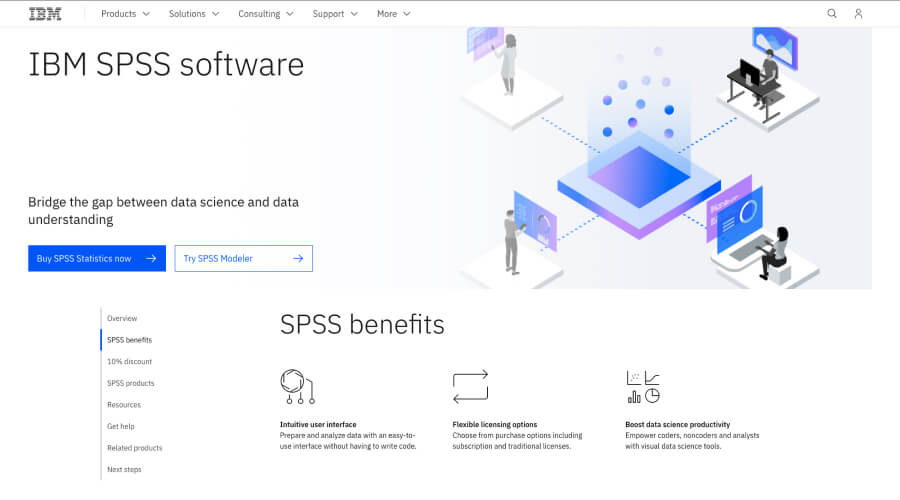
At number 1, we have IBM SPSS. SPSS is a quantitative analysis tool that is widely used for statistical analysis. It is apt to analyze diverse field data such as education, market, healthcare, government, and retail. The software interface is designed to be user-friendly, making it easy to gather and analyse large amounts of data. It also provides the ability to interpret statistical patterns.
Prefer using IBM SPSS for conducting comprehensive statistical analysis and managing data. Plus, it assists you in getting accurate data-driven results, whether it is a small or large data collection. Therefore, choose the most suitable quantitative analysis tool to improve your business.
Price: They offer monthly and annual subscriptions that start from USD 99, and their premium price is USD 8,540.
2. Stata
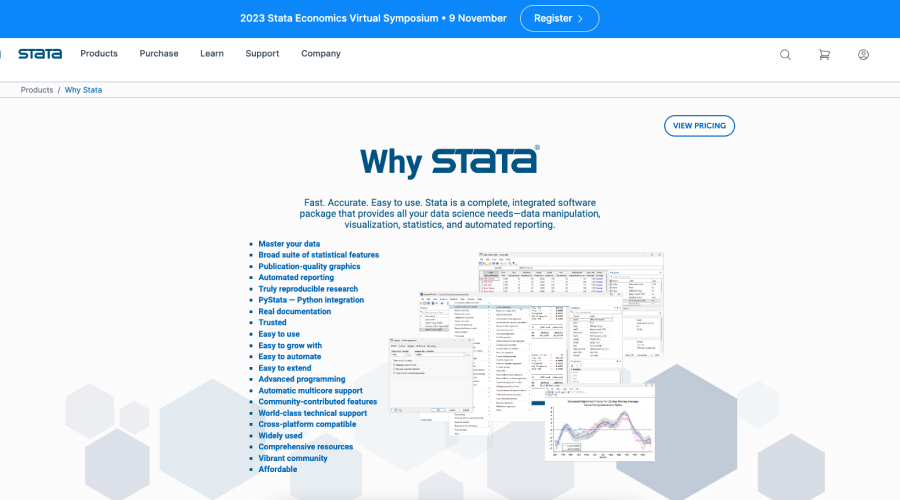
Next on our list is Stata. Stata is an integrated software package to generate automated reports, data statistics, visualization, and data manipulation. When it comes to the best quantitative research tools, Stata is one of them. This tool is used to simplify the complex analysis and tasks. Thus, opt for it and elevate your research process.
Price: They offer a FREE trial, and pricing starts from $765.00.
3. Power BI
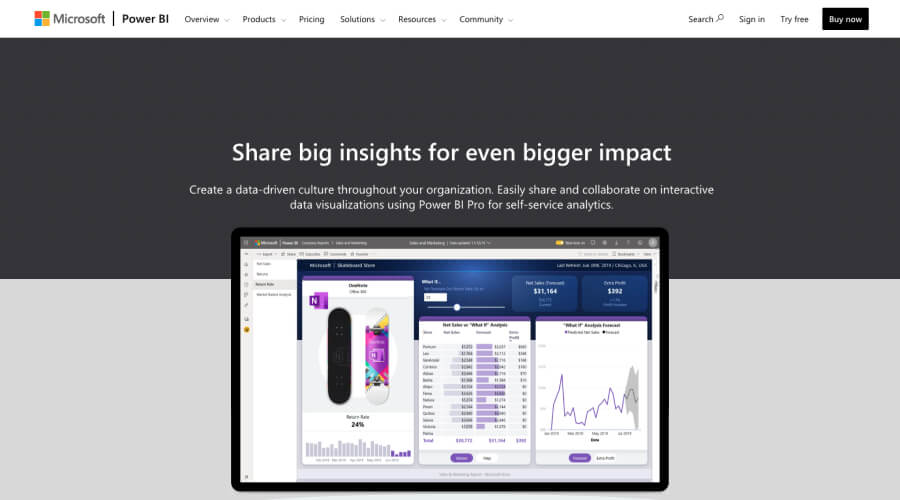
Power BI is an efficient tool that turns any unrelated data source into interactive insights. This quantitative analysis tool is quite different from Excel spreadsheets because it organizes the files and performs calculations.
Thus, you can choose Power BI to get creative interactive reports from unrelated data sources. And it plays a vital role in overall business analytics and visualizing data. Hence, embrace Power BI to elevate your analysis and research process.
Price: It has three options: a free, pro, and premium version. PowerBi Pro starts from $10 per month, and the premium starts from $20 per month.
4. SAS – Statistical Analysis Software

It is statistical software developed for data visualization, acquiring meaningful insights, reporting, and giving a clear statistical analysis of collected information. SAS can deal with large and complex data sets, which offers accurate results.
As a next step, SAS provides you with an idea for predictive modeling that helps to get a clear and meaningful thought about the final output. Therefore, opt for such quantitative analysis tools to achieve your timely goals.
Price: You can check the official site to know about the pricing details.
5. Tableau
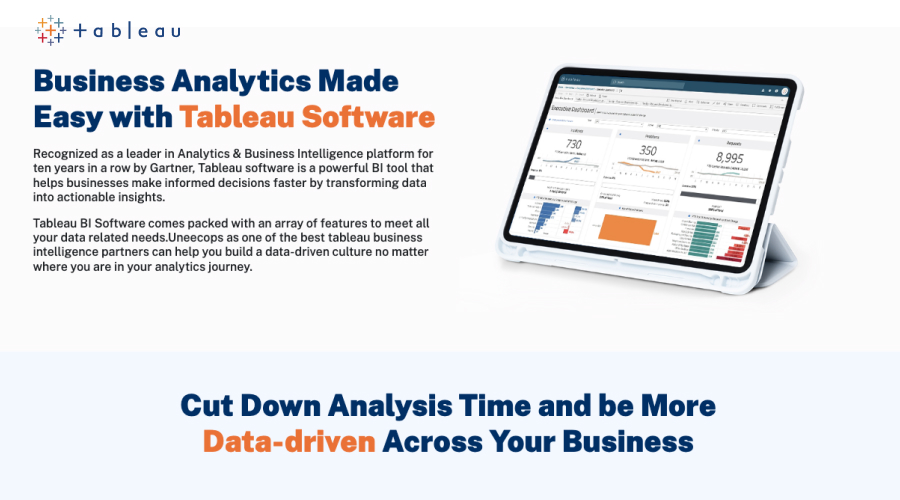
Tableau stands out as the top choice among various quantitative analysis tools due to its exceptional capabilities in data visualization and interactive dashboard creation. Additionally, this platform is highly advantageous for numerous users due to its ability to provide limitless opportunities for improving quantitative research and analysis.
Therefore, selecting Tableau is crucial for obtaining precise outcomes in your quantitative research and analysis.
Price: It is absolutely FREE.
In addition to quantitative research tools, research methodologies also play a crucial role when it comes to making informed decisions. Here is our list of some of the best research methodologies; take a look…
Best Quantitative Research And Analysis Methodologies
1. Survey Methodology
When it comes to research or analysis, everyone needs to dig deeper to gain enough knowledge on that particular topic. This rule follows in every process, which is also applicable in quantitative research and analysis.
Survey Methodology is all about conducting and analyzing surveys in every possible way. From traditional paper surveys to online form submission, everything falls under this category. First, analyze your groups and conduct a survey according to their requirements. It gives you clarity about your potential targeted community and creates the right path to move on.
2. Opinion Poll
There is no need for a particular introduction for an opinion poll from the name you could’ve guessed. Yes, an opinion poll is usual, yet an effective quantitative and qualitative research tool and method followed to get accurate results.
Opinion polls are the simplest way to gather a huge amount of data from a diverse range of audience. The main motto of the poll should be getting answers to the question of why. After collecting enormous answers from various groups of people, you get the exact answers according to your requirements. So, include it in your research tool list to witness better outcomes.
3. Questionnaire
The questionnaire is a straightforward and effective method for identifying your potential users or target communities, as well as understanding their needs and preferences. By conducting thorough research and providing a variety of responses, you can gain a comprehensive understanding of people’s specific requirements. This tool helps you create a product or service that caters to your specific target audience.
4. Descriptive Research Design
As the name suggests, it is a descriptive method that helps to identify the attributes, trends, categories, situations, and population. It is comparatively simple and easy to use. You can use it to gather more details about the larger population.
Once you complete the survey, implementing qualitative analysis and research methods is suggestible to get accurate feedback and information. Moreover, you can be aware of the overall satisfaction level of consumers or potential users.
5. Sampling
Once you complete the above-mentioned strategies, you can start sampling. It plays a huge part in the overall research phase. Sampling is nothing but pre-launch testing, i.e., examining the final product with the people in the previous survey list.
Typically, there are four types of sampling available such as random, block, judgment, and systematic sampling. According to the project scale, sampling varies, and also, you can try conducting every sampling method if it is necessary.
Utilize the quantitative and qualitative research tools and methodologies effectively to witness extraordinary results. Take a look at some of the examples of quantitative research…
Examples Of Quantitative Research
To examine the meaning of this term in the context of the business world, make use of both quantitative and qualitative research tools. Some exact scenarios are portrayed here. You can consider utilizing them and enhance your organization, projects, or others.
Take a survey,
- Analyze competitor’s sales with yours in all terms
- Examine your targeted community rate
- Gather ideas from your potential customers through voting
- Analyze the growth with the new customers
- Go through click-through rates and engagement percentage
- Compare your previous year’s growth with the current period
- Check the overall ratings and reviews in terms of percent
In common, every time you analyze with the help of numerical data and information. Therefore, make sure you follow the same in the quantitative research and witness gradual successful outcomes.
Difference Between Quantitative And Qualitative Research
Obviously, now even you can point out the exact difference between quantitative and qualitative research tools and techniques, isn’t it? But, to make sure that you do not miss out on any points, here you can explore the differences!
Quantitative Research
When it comes to quantitative research, it is all about static and dynamic data, which is, of course, an essential aspect of decision-making. Know that numerical information holds a huge value. Quantitative research focuses on understanding real-world entities, which are categorized based on various factors. It includes locality, gender, age, and other basic determinants.
The quantitative analysis depends on the research process, which helps to sort out the communities uniquely based on business requirements. Utilizing quantitative research tools like online surveys, polls, questionnaires, or other technical methods is of utmost importance. These tools give accurate outcomes. Here is how they are different from quantitative research:
It is objective and shows everything in graphs and numbers
This approach requires many particulars and can analyze information over a long period
Can take surveys with a random sample and information.
Qualitative Research
While discussing an organization’s growth, two factors are vital, which include research and analysis. In the qualitative research phase, you must conduct surveys and work on various aspects of why people stick to a product or service for a long period. Doing so helps entrepreneurs make better business decisions that help them towards growth. When it comes to qualitative analysis and research, businesses must opt for the top-rated qualitative research tools that assist in identifying good results.
On the other hand, in the analysis phase, attributes of individuals or consumers help you to identify how some organizations attract consumers. In quality analysis, you get accurate answers to these queries with detailed insights. Thus, choosing the best qualitative analysis tools to witness gradual growth is indispensable! Here is how qualitative research helps:
This approach is all about content information based on purpose
It can connect with targeted communities and provide more executable results
It requires only a few people from the targeted communities.
Final Thoughts
Let’s now conclude our post Quantitative And Qualitative Research Tools And Techniques. We hope that this post has been enlightening and will help you make an informed choice. Embrace the latest quantitative and qualitative research tools and techniques to enhance the business or complete the project promptly. It reduces your burden and helps you achieve success in your path. The selection of the right tool is crucial in order to achieve the desired outcome. So, choose wisely!


